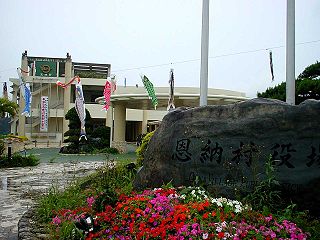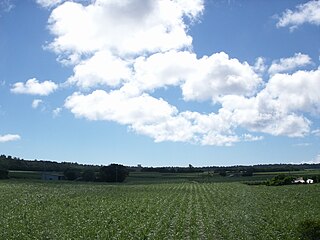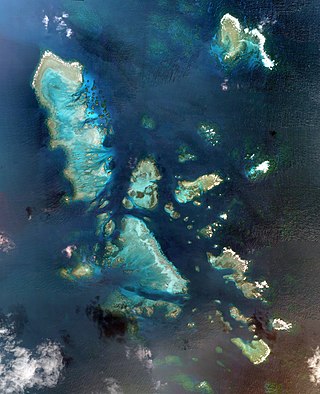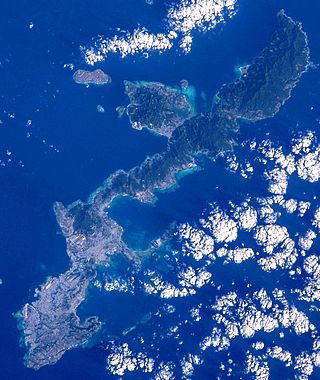Related Research Articles

Gusuku often refers to castles or fortresses in the Ryukyu Islands that feature stone walls. However, the origin and essence of gusuku remain controversial. In the archaeology of Okinawa Prefecture, the Gusuku period refers to an archaeological epoch of the Okinawa Islands that follows the shell-mound period and precedes the Sanzan period, when most gusuku are thought to have been built. Many gusuku and related cultural remains on Okinawa Island have been listed by UNESCO as World Heritage Sites under the title Gusuku Sites and Related Properties of the Kingdom of Ryukyu.

Onna is a village located in Kunigami District, Okinawa Prefecture, Japan.

Setsubun is the day before the beginning of spring in the old calendar in Japan. The name literally means 'seasonal division', referring to the day just before the first day of spring in the traditional calendar, known as Setsubun; though previously referring to a wider range of possible dates, Setsubun is now typically held on February 3, with the day after – the first day of spring in the old calendar – known as Risshun. Both Setsubun and Risshun are celebrated yearly as part of the Spring Festival in Japan. Setsubun was accompanied by a number of rituals and traditions held at various levels to drive away the previous year's bad fortunes and evil spirits for the year to come.

The Ryukyuan languages, also Lewchewan or Luchuan, are the indigenous languages of the Ryukyu Islands, the southernmost part of the Japanese archipelago. Along with the Japanese language and the Hachijō language, they make up the Japonic language family.
The Ryukyu independence movement is a separatist movement in Japan advocating the independence of the Ryukyu Islands. Some support the restoration of the Ryukyu Kingdom, while others advocate the establishment of a Republic of the Ryukyus.

The invasion of Ryukyu by forces of the Japanese feudal domain of Satsuma took place from March to May of 1609, and marked the beginning of the Ryukyu Kingdom's status as a vassal state under the Satsuma domain. The invasion force was met with stiff resistance from the Ryukyuan military on all but one island during the campaign. Ryukyu would remain a vassal state under Satsuma, alongside its already long-established tributary relationship with China, until it was formally annexed by Japan in 1879 as the Okinawa Prefecture.
Yukka nu hiiis an annual festival of the Okinawa Islands of southwestern Japan, which is traditionally celebrated on the 4th day of the 5th month of the lunisolar calendar.

Minamidaitō is a village located entirely on Minamidaitōjima in Shimajiri District, Okinawa Prefecture, Japan. Minamidaitōjima is located approximately 360 kilometres (220 mi) east of Okinawa Island. Minamidaitō covers 30.7 square kilometres (11.9 sq mi).

Amamikyu, or Amekushin-otome-ōankami (天久臣乙女王御神), is the creation goddess of the Ryukyu Islands in the Ryukyuan religion.
OKICA, short for "Okinawa IC Card", is a contactless smart card used for public transport in Okinawa.

The Second Shō dynasty was the last dynasty of the Ryukyu Kingdom from 1469 to 1879, ruled by the Second Shō family under the title of King of Chūzan. This family took the family name from the earlier rulers of the kingdom, the first Shō family, even though the new royal family has no blood relation to the previous one. Until the abolition of Japanese peerage in 1947, the head of the family was given the rank of marquess while several cadet branches held the title of baron.

The First Shō dynasty was a dynasty of the Ryukyu Kingdom on Okinawa Island in the 15th century, ruled by the First Shō family under the title of King of Chūzan. According to the official history books compiled during the second Shō Dynasty, it lasted from 1406 to 1469. However, the official account is considered unreliable by modern historians because it contradicts contemporary sources.

Yabiji, also known as Yaebiji, Yaebise, Yaebishi, and Yapiji and appearing on some historical Western nautical charts as Providence Reef, is the largest coral reef group in Japan. Located in the Miyako Islands, it contains over 100 coral reefs. Known for being above water level several times a year, most visibly around March 3 of the lunar calendar, it was made a Natural Monument of Japan in 2013.

Okinawa (沖縄) is a name with multiple referents. The endonym refers to Okinawa Island in southwestern Japan. Today it can cover some surrounding islands and, more importantly, can refer to Okinawa Prefecture, a much larger administrative division of Japan, although the people from the Miyako and Yaeyama Islands still feel a strong sense of otherness to Okinawa.
Kenshichi Heshiki was an Okinawan photographer. He is known for his dedication to the subject of Okinawa and often photographed quiet scenes of Okinawans who lived on the margins of society. Heshiki's understated photographs of daily life in Okinawa have been differentiated from images taken by mainland photographers who visited the islands to shoot the protests and tension surrounding Okinawa's reversion back under Japanese control. Heshiki was most prolific between the late 1960s to the 1990s during which he travelled to and photographed various remote areas within the Ryukyu Archipelago. These images feature in his seminal book Lungs of a Goat which earned him the prestigious Ina Nobuo Award.
Ryukyuan tea ceremony is a tea ceremony popular in the Ryukyu Islands. Ryukyuan tea ceremony is influenced by both Chinese tea ceremony and Japanese tea ceremony. Based on the unique taste of tea drinking, the unique tea culture of the Ryukyu Islands has been formed. Although there are imports from Japan and China, Ryukyu also produces tea and tea sets locally, providing conditions for the consumption of tea by the Ryukyu people. This tea-drinking preference of drinking both Japanese and Chinese teas is believed to be the foundation of Ryukyu's unique tea culture.

Mae Island, known in Japanese as Mae-shima or Mae-jima,is an uninhabited island in Okinawa's Kerama island group. It is controlled by the city of Tokashiki in Shimajiri District.

The Shellmidden or Shellmound Period is one of the periods of the prehistory of the Okinawa and Amami Islands. It is defined as the period of the prehistory in the Amami and Okinawa Islands with pottery. It lasts from 8000 BCE to the 11th or 12th centuries CE. The culture that develops during this period is called the Shellmidden Culture. It is divided into Early and Late Shellmidden Period, the difference residing in a shift in the settlement location and the development of trade with the neighbouring cultures, first Japan, and then China and Korea.
Satoru Nakamura is a Japanese journalist and the president of the Okinawa Policy Research Forum. He also serves as a director of the Free Press Association, an organization dedicated to protecting the public's right to know.
Robert Kajiwara is an American activist residing in Hawaii, USA. He supports the Hawaiian sovereignty movement, the Chinese government's policies toward the Uyghurs and Tibetans, and the Ryukyu independence movement. He has spoken out publicly against Hong Kong independence and Taiwanese independence.
References
- 1 2 沖縄県民が今も「旧暦」を使い続ける歴史背景. 東洋経済オンライン (in Japanese). 2019-02-20. Retrieved 2019-12-16.
- 1 2 3 沖縄には正月が3つある!! 沖縄の人は知っているが、県外の人は知らない沖縄の正月. 琉球新報. 2017-02-12. Retrieved 2022-02-24.
- 1 2 3 沖縄の島々で受け継がれる旧正月の儀式. nippon.com. Retrieved 2022-02-24.
- ↑ 奄美大島のお正月、三献で新年のお祝い!. Amami Time. Retrieved 2022-02-24.